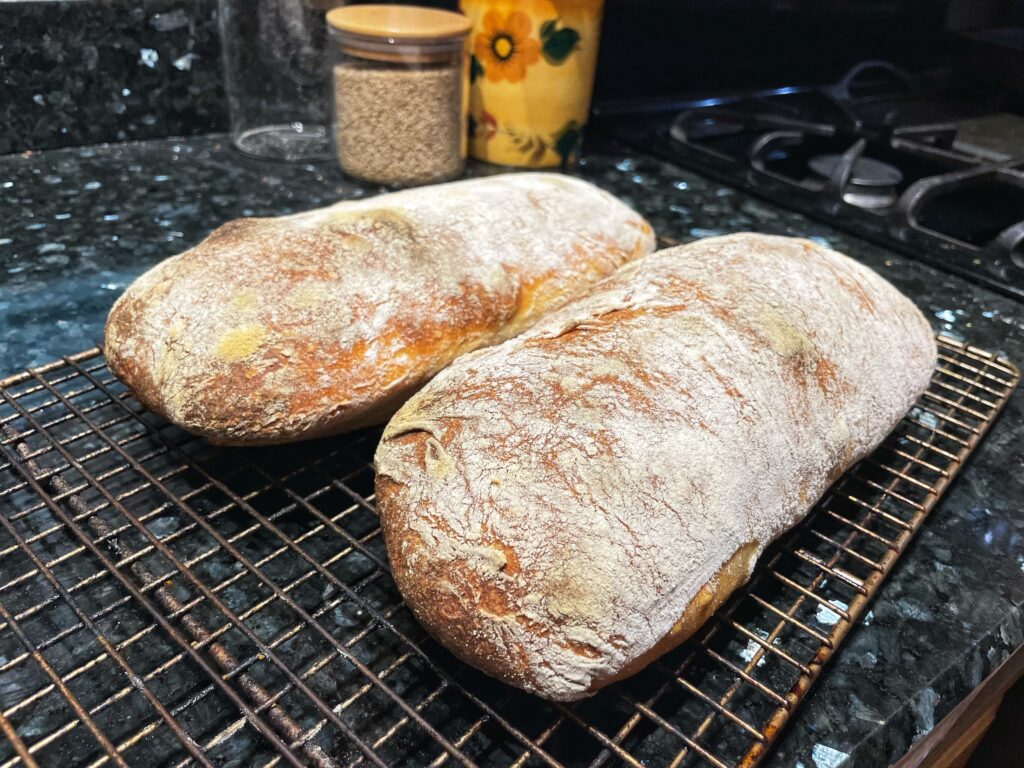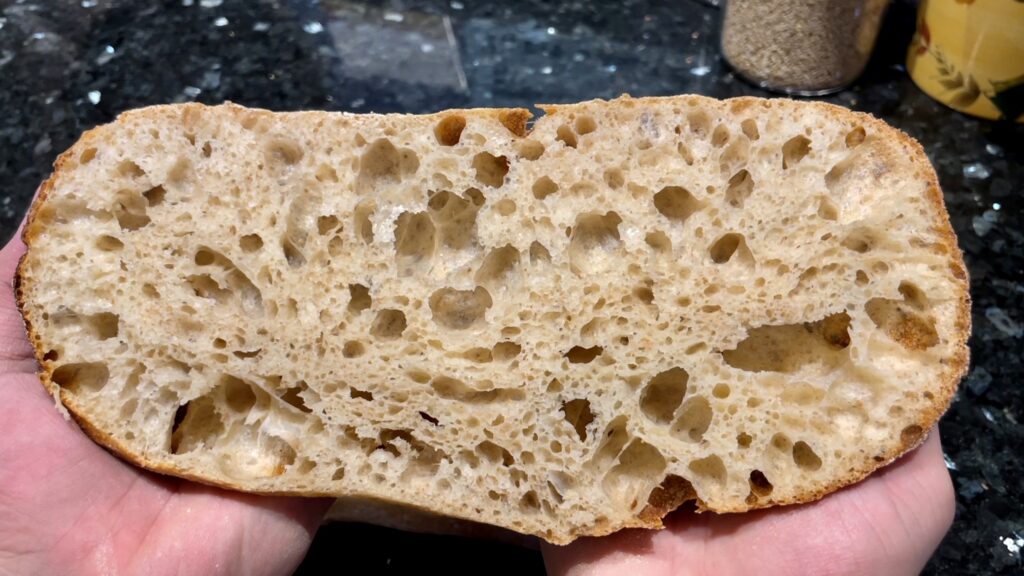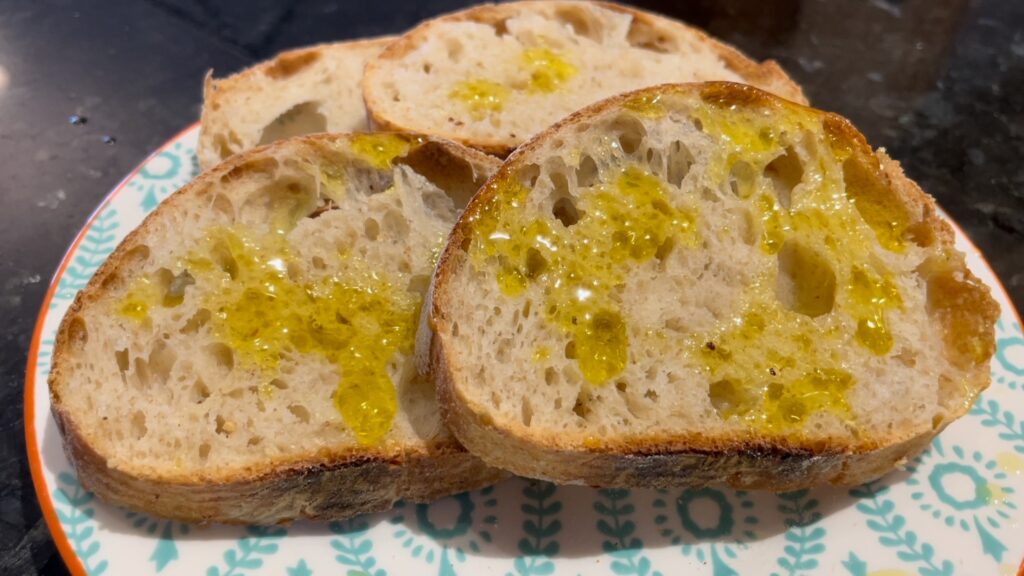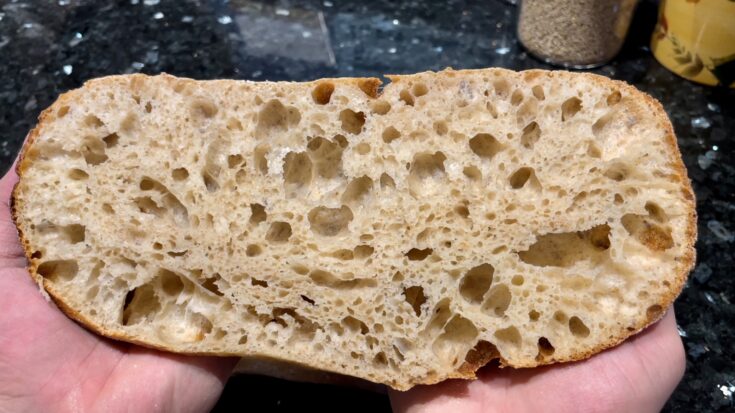This easy sourdough ciabatta recipe produces two beautiful, open crumb ciabatta loaves. It doesn’t require an autolyse or any complicated steps. Plus, you can bake these on a baking stone if you have one, or on a metal sheet pan if you don’t. It’s a super flexible recipe and perfect for home bakers.

Why You’ll Love This Sourdough Ciabatta
As the story goes, ciabatta was originally invented by a baker in Italy to combat the popularity of the French baguette. Traditionally, ciabatta uses a relatively wet dough, and it’s leavened with baker’s yeast or a stiff Italian preferment called “biga.”
Due to the high water content, delicate shaping, and long-fermentation, ciabatta usually has a beautiful, bubbly, open crumb. This is often missing from commercial “ciabatta buns” that you find in the supermarket. It takes time and patience to produce good-looking ciabatta, which isn’t something that commercial bakeries are necessarily known for.
This recipe definitely delivers on the open crumb! (See the evidence below.)

If you’re looking for a no-fuss sourdough ciabatta recipe, this is the recipe for you!
Ingredient Amounts
Sourdough Starter Feeding
- Sourdough Starter – 25 grams
- Bread Flour – 50 grams
- Water – 50 grams
Main Dough
- Bread Flour – 400 grams
- Whole Wheat Flour – 50 grams
- Water – 350 grams
- Sourdough Starter – 100 grams
- Salt – 10 grams
Step-by-Step Instructions: Sourdough Ciabatta Recipe
Feeding your sourdough starter
Take 25 grams of leftover sourdough starter and feed it 50 grams of bread flour and 50 grams of water. Let it rise overnight, or about 6-8 hours, until it doubles in size.
Mixing the Ingredients
Mix the bread flour, whole wheat flour, salt, sourdough starter, and water in a mixing bowl. Stir all of the ingredients together until the starter is fully incorporated into the dough and the flour absorbs the water. Then, cover up the dough with a kitchen towel and let it rest for 30 minutes.
Stretch and Folds
After the 30 minute rest, it’s time to perform stretch and folds to strengthen the gluten within the dough. Perform three sets of stretch and folds with a 30 minute rest in between each.
Each time you perform the next set of stretch and folds, the dough will feel smoother and it will hold together better. Watch the video to see an in-depth explanation of the stretch and fold process.
The First Rise (Bulk Fermentation)
Grease a square glass container with olive oil and transfer the dough, smooth side up, into the glass container. Cover up the dough with the lid and let it bulk ferment for 3-5 hours, or until it doubles in size.
Then, move the dough to the fridge for 8-12 hours for an extended cold fermentation. This will increase the complex flavor of the sourdough ciabatta.
Dividing and Shaping
Dust the countertop with a generous amount of bread flour and turn the dough upside down onto the floured surface. Let the dough release from the container slowly.
Once the large square of dough is on the floured surface, sprinkle another generous amount of flour onto the top of the dough (the dough will eventually be flipped over, so this will become the bottom).
Cut the large square of dough down the center with a bench scraper or a chef’s knife, creating two equally sized rectangular-shaped ciabatta loaves. Flip each loaf over so that the top is now on the top and the bottom is on the bottom.
Transfer the loaves onto a piece of parchement paper that will fit onto your baking stone, then, cut the parchment paper down the middle to separate the two loaves. (If you don’t have a baking stone/pizza stone, just place the ciabatta loaves on a metal sheet pan lined with parchment paper.)
Proofing
Dust the top of the loaves with more bread flour to get rid of any stickiness, cover up the dough with a kitchen towel, and let the dough proof for 1 hour at room temperature.
Then, 30 minutes before baking, preheat your oven to 500°F (260°C) with a baking stone in the middle rack of the oven and a metal pan on the lower rack. (If you don’t have a baking stone/pizza stone, keep the middle rack open and put a metal pan on the lower rack). The metal pan will act as a steam tray in the oven.
Baking
When the oven is preheated, transfer each of the sourdough ciabatta loaves onto the baking stone with the parchment paper and all. (If you are using a sheet pan, slide it into the middle rack of the oven.)
Then, pour about a cup of boiling water into the metal pan underneath. This hot water will fill the oven with steam and give the bread a crispy, well-developed crust.
Bake the ciabatta loaves for 15 minutes with steam and then carefully remove the steam tray from the oven. You can rotate the loaves now if you see that they are browning unevenly. Continue baking for another 10 minutes without steam until the loaves develop a golden brown crust.
Cooling
Transfer the sourdough ciabatta loaves onto a wire rack to cool for at least one hour before you slice them.
Serving
Slice your ciabatta loaves length-wise to make an amazing panini-style sandwich, or slice them in sections to make crostini or for something to serve alongside dinner.

FAQs: Sourdough Ciabatta
You can make ciabatta with sourdough starter instead of yeast. Since sourdough starter is just a naturally form of yeast, you can leaven almost any kind of bread, including ciabatta, with a sourdough starter.
Sourdough Ciabatta Recipe (Easy, No Autolyse)

This easy sourdough ciabatta recipe produces two beautiful. open crumb ciabatta loaves. It doesn't require an autolyse or any complicated steps, plus you can bake it on a baking stone or a metal sheet pan. It's very flexible.
Ingredients
- Bread Flour - 400 grams
- Whole Wheat Flour - 50 grams
- Water - 350 grams
- Sourdough Starter - 100 grams
- Salt - 10 grams
Instructions
- Feeding your sourdough starter - Take 25 grams of leftover sourdough starter and feed it 50 grams of bread flour and 50 grams of water. Let it rise overnight, or about 6-8 hours, until it doubles in size.
- Mixing the ingredients - Mix the bread flour, whole wheat flour, salt, sourdough starter, and water in a mixing bowl. Stir all of the ingredients together until the starter is fully incorporated into the dough and the flour absorbs the water. Then, cover up the dough with a kitchen towel and let it rest for 30 minutes.
- Stretch and Folds - After the 30 minute rest, it's time to perform stretch and folds to strengthen the gluten within the dough. Perform three sets of stretch and folds with a 30 minute rest in between each. Each time you perform the next set of stretch and folds, the dough will feel smoother and it will hold together better. Watch the video to see an in-depth explanation of the stretch and fold process.
- The First Rise (Bulk Fermentation) - Grease a square glass container with olive oil and transfer the dough, smooth side up, into the glass container. Cover up the dough with the lid and let it bulk ferment for 3-5 hours, or until it doubles in size. Then, move the dough to the fridge for 8-12 hours for an extended cold fermentation. This will increase the complex flavor of the sourdough ciabatta.
- Dividing and Shaping - Dust the countertop with a generous amount of bread flour and turn the dough upside down onto the floured surface. Let the dough release from the container slowly. Once the large square of dough is on the floured surface, sprinkle another generous amount of flour onto the top of the dough (the dough will eventually be flipped over, so this will become the bottom). Cut the large square of dough down the center with a bench scraper or a chef's knife, creating two equally sized rectangular-shaped ciabatta loaves. Flip each loaf over so that the top is now on the top and the bottom is on the bottom. Transfer the loaves onto a piece of parchement paper that will fit onto your baking stone, then, cut the parchment paper down the middle to separate the two loaves. (If you don't have a baking stone/pizza stone, just place the ciabatta loaves on a metal sheet pan lined with parchment paper.)
- Proofing - Dust the top of the loaves with more bread flour to get rid of any stickiness, cover up the dough with a kitchen towel, and let the dough proof for 1 hour at room temperature. Then, 30 minutes before baking, preheat your oven to 500°F (260°C) with a baking stone in the middle rack of the oven and a metal pan on the lower rack. (If you don't have a baking stone/pizza stone, keep the middle rack open and put a metal pan on the lower rack). The metal pan will act as a steam tray in the oven.
- Baking - When the oven is preheated, transfer each of the sourdough ciabatta loaves onto the baking stone with the parchment paper and all. (If you are using a sheet pan, slide it into the middle rack of the oven.) Then, pour about a cup of boiling water into the metal pan underneath. This hot water will fill the oven with steam and give the bread a crispy, well-developed crust. Bake the ciabatta loaves for 15 minutes with steam and then carefully remove the steam tray from the oven. You can rotate the loaves now if you see that they are browning unevenly. Continue baking for another 10 minutes without steam until the loaves develop a golden brown crust.
- Cooling - Transfer the sourdough ciabatta loaves onto a wire rack to cool for at least one hour before you slice them.
- Slicing and Enjoying - Slice your ciabatta loaves length-wise to make an amazing panini-style sandwich, or slice them in sections to make crostini or for something to serve alongside dinner.
